Julia Child would probably have a hard time getting behind this concept, Mario Batali I’m guessing would not enjoy the delights of cleaning up a red sauce pan with no running water, Mimi Thorisson would perhaps handle it best since she is used to living in a country farmhouse which I imagine has had it’s own share of homesteading dilemmas. (She’d also probably do a killer job with the wine pairings!)

I feel like first I should explain what a “Dry Cabin” is, since many folks are unclear on the term unless they spent some time in Alaska where no one bats an eye at no running water. (Those Alaskans are tough!) A dry cabin means a cabin without running water. While we have full amenities in the summer, the cabin’s water is gravity fed from a creek which freezes in the winter. We also have to drain the cabin completely dry when the temperatures start to drop consistently to insure that none of the pipes burst, which translates to we also can’t dispose of any water down the drains in the winter either.
While dry cabin cooking likely isn’t for everyone, it’s mostly a matter of getting creative with managing kitchen mess and clean-up, as well as coming up with simple dishes with limited ingredients. This is important when everything you use has to be either frozen and stored from the fall, dragged in on a sled, carried on your back, or occasionally thrown like a piece of airline luggage and picked up several paces later. (This tactic I sometimes employ when the snow is particularly deep and I’m feeling particularly fed up with whatever I am lugging.)
The first winter season we did the obvious. Stocked the cabin with cans of chili, grits, pasta sauce, canned tuna. All those things you imagine would keep in the rapidly changing temperatures and still be easy to cook. Seemed like a brilliant idea, that is until you go to clean up all those pots and pans with melted snow!
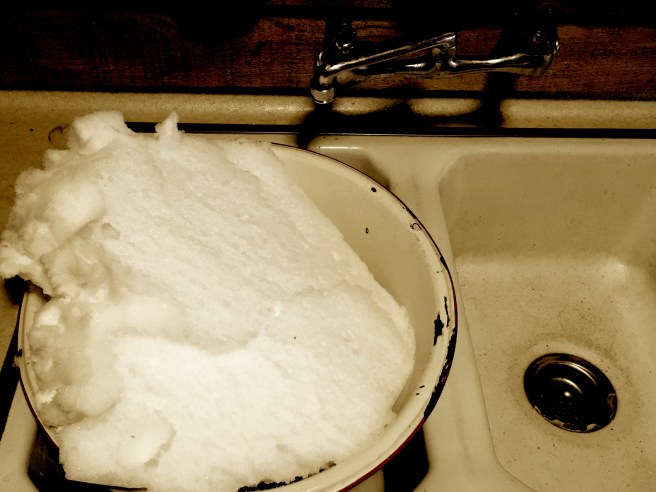
I recall the first time we made tomato sauce and it was time to rinse the pan. First there is the matter of melting snow and making water. Then there is the dilemma of how to scrub the pan. I started the first time with a regular sponge. I then realized I also needed to clean the sponge. This required melting more snow and soaking it in a pan of hot water. But then wait, now I needed to clean the pan again because the tomato sauce from the sponge was now back on the sides of the pan. The joys of cabin living never cease to surprise one….!
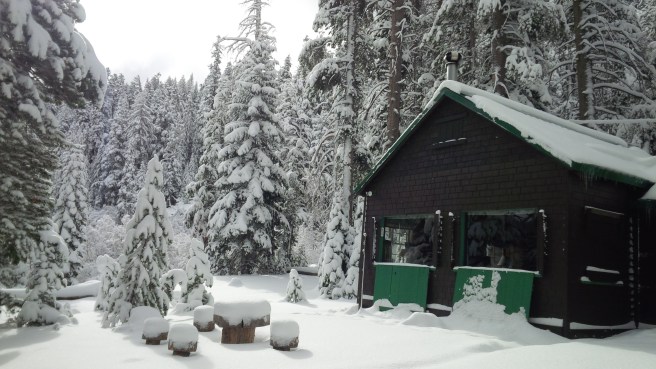
Next it became time to rid ourselves of the dirty water. Since we can’t pour anything down the drains because the water would sit in there and freeze the pipes it all had to be disposed of outside. After throwing the red water out into the snow I realized this looked very similar to a murder scene and probably not the best message to be sending to any random passersby. I also came to the conclusion that if there were any starving bears or mountain lions around this probably was akin to ringing a critter dinner bell.
Obviously there is a lot more to this winter cabin cooking than I realized…
As we start on winter season part deux we have gotten a lot wiser about how to handle the cooking. In Louisiana cooking the “Holy Trinity” is always considered mandatory: Onions. Bell Peppers. Celery.
At the cabin we quickly have come up with our own version of the “Trinity” :
Paper Plates. Aluminum Foil. Wet Wipes.
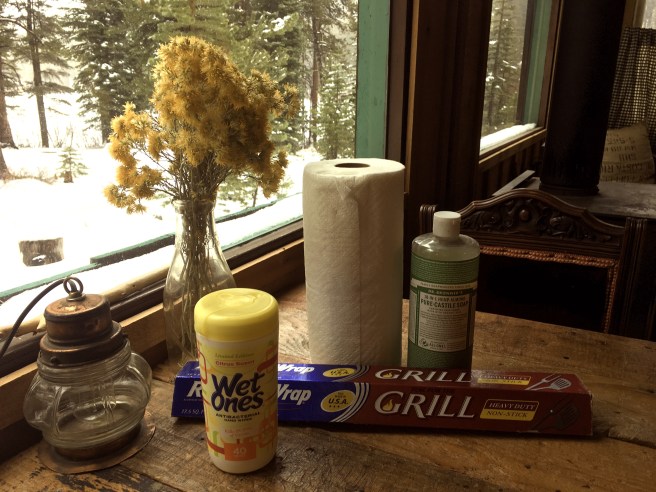
As eco friendly as we are in our daily home those rules quickly got tossed out the proverbial rustic window at the cabin. For winter use we realized that good old fashioned paper plates were the way to go. Although, since we tend to use the same couple of paper plates for most of the day instead of constantly rinsing china plates, perhaps the water conservation balances out against the paper waste.
I decided to record my first day of winter cabin cooking this year…
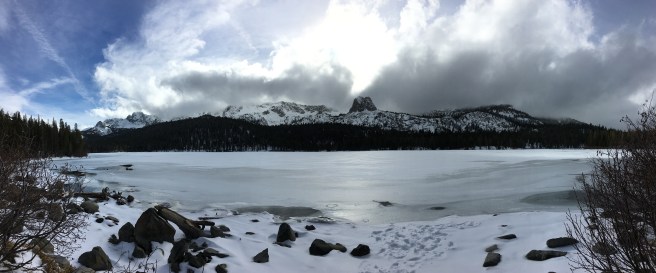
For breakfast I normally have fresh ingredients handy. It’s always lovely to have a nice leisurely mountain breakfast on a snow day, something hearty and comforting to keep your belly warm and cozy and help insulate you against the less than tropical temperatures.
One of my favorites is a potato and egg omelette. You can make this in a traditional Spanish way where it comes out more like an egg cake or my favorite way, which is messy and loose. More like an omelette scramble.
Loose ingredients for one serving:
1-2 Small Potatoes Cut Into Small, Thin, French Fry Style Pieces
Handful of Chopped Green Onions
2 Eggs
Olive Oil
Salt & Pepper
For the cabin the cast iron skillet is unavoidable and essential! Not only does it look good in situ but it is by far the easiest pan to clean.
First decision today, which bottle of frozen olive oil should I use for this recipe? Winter cabin cooking problem # 1 – everything freezes!

I start out putting enough olive oil in the pan to coat the bottom and have a nice layer for the potatoes. I tend to not use too much oil and more sauté them rather than deep fry.

I scramble the 2 eggs in a paper bowl with the handful of green onions and salt and pepper, then set them aside.
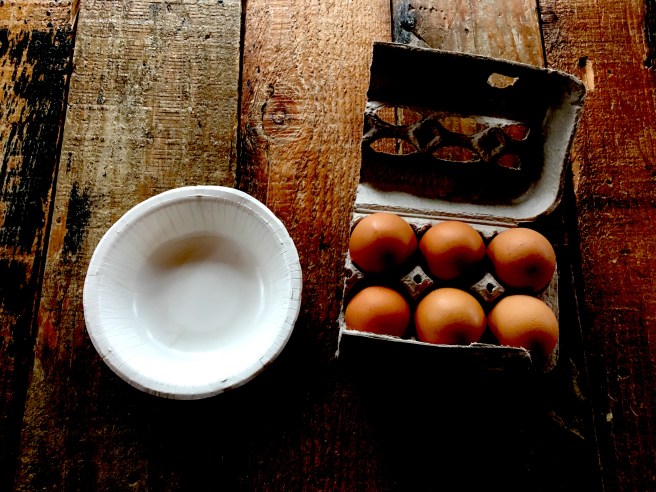
I cook the potatoes until they break easily with a fork. Depending on how much oil is left in the pan I either drain and pat dry the potatoes or just blot them dry in the pan to remove the excess oil. I usually lower the fire a bit so the pan isn’t so hot when I add in the eggs.
After the pan is the right temperature I add in the eggs and keep them moving with the potatoes until they are done but before they start to brown.
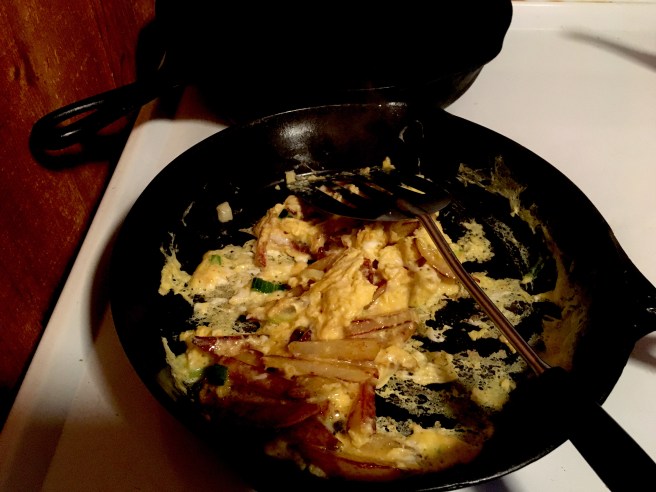
Then serve immediately. You can also garnish with additional green onions if you like. Bon appetite!

For this recipe I brought in the eggs and potatoes but had green onions chopped and frozen in the freezer. This is a practice I learned from my New Orleans upbringing where we always kept at least this part of the trinity frozen and ready for eggs!
The clean up is very easy on this one. While the pan is still hot I use the spatula to scrape any egg residue up. After the pan cools I simple dump out the egg residue in the trash and then use a paper towel to wipe down the pan. Voila. The oil residue keeps it perfectly seasoned for the next use!
After a large breakfast I tend to just eat some snacks for lunch so the next meal up for today was dinner. After an afternoon of harvesting deadfall wood in the snow and testing my mettle with the axe, I decided that a hearty lumberjack meat dish was sounding pretty good for supper..!

I had stocked the freezer in the fall with a couple packs of ground bison and decided to make a meat loaf. I prefer bison over ground beef as it’s much leaner and cleaner than ground meat. This is a much messier dish to put together. I stock larger paper bowls for cooking projects like this one.
Ingredients:
1lb Bison Meat
Handful of Chopped Onion
Handful of Chopped Green Onion
1 Egg
Handful of Italian or Homemade Bread Crumbs (Optional)
Salt & Pepper
First dilemma for this recipe is how to thaw out the solid as a brick frozen meat in a below freezing cabin setting.
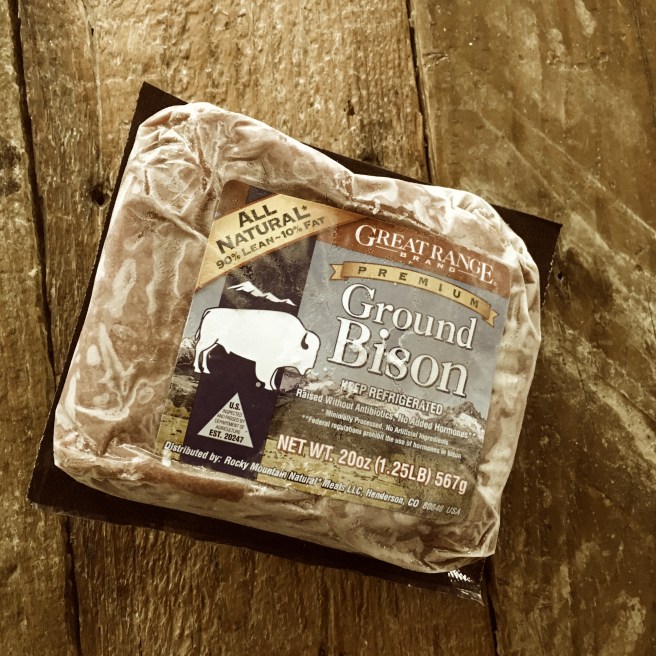
Well you collect some snow of course!

If you are scratching your head at that one and imagining that I’m some kind of outdoor magical genius let me be very clear, I am NOT and I have the scars to prove it.
I collect the the snow and then build a very hot fire in the wood stove. I then take the cast iron skillet and throw some fresh snow in it to thaw.
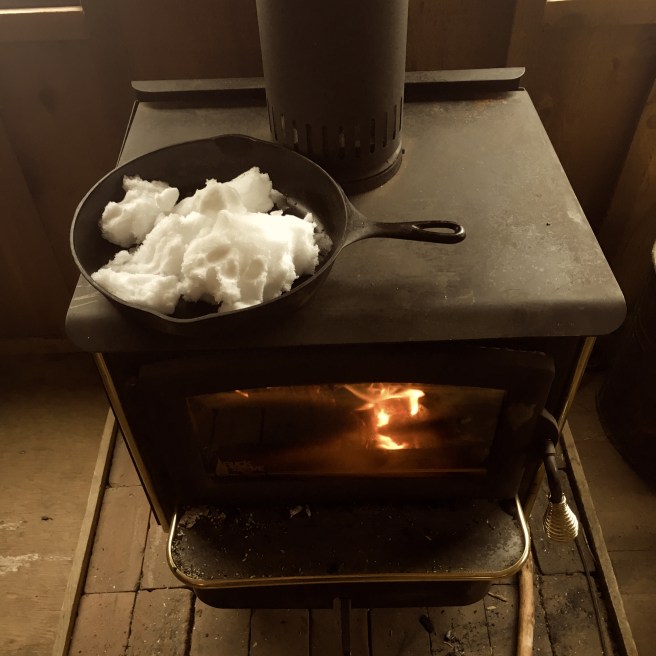
After that powdery goodness reverts to it’s liquid state I add in the pack of frozen bison meat and let the stove do it’s job. It’s important however to keep an eye on the meat so it doesn’t start to cook in this set up!

I take the bison meat out of it’s package and drain off any excess liquid or you can pat it dry with paper towels. I salt and pepper the meat. Throw in the onion, green onion, egg, and bread crumbs. (If you’d rather not add the carbs you can leave off the bread crumbs.)
I massage this all together until it is well blended. (This is the messiest part of this recipe since cleaning up your hands is a chore with no water!) Next I take a medium size piece of heavy aluminum foil (the one for grilling works great!) and create a pan out of it by folding up the edges. Then you simply mold the prepared meat mixture into a loaf and place it onto the aluminum foil and pop it into a pre-heated oven. I normally go 350 degrees but you can adjust as needed. The altitude wreaks havoc on oven cooking so it’s always wise to pay attention and a meat thermometer comes in handy.

This is great pared with a baked potato or sweet potato in the oven, frozen peas, or any other easy to steam veggie.
Clean-up on this is also a piece of cake. You are basically just throwing out the used bowl and aluminum foil. Minimum trash and no dishes to clean!
And for those of you wondering about the hand washing I normally melt and boil some snow and then use some good old Dr. Bronner’s soap to finish the job which is biodegradable and environmentally safe so the water can be tossed outside with aplomb!


Great story and love the photos! Also, did not know it was a “dry cabin”, but clearly you have figured out how to make it all work.
LikeLike
It’s only “dry” in the winter when the water supply freezes! Have no fear if you visit in the summer we have full running water and hot showers!
LikeLike